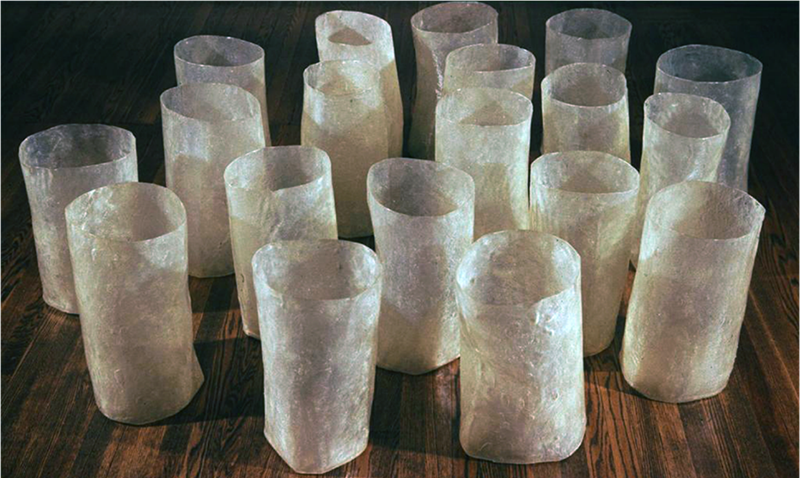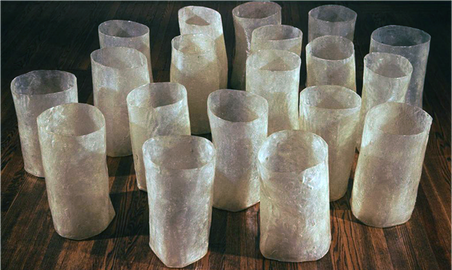
German- American sculptor Eva Hesse is world-renowned for her drawings, paintings and sculptures, which brought deeply resonant emotions into the structured realms of Minimalism.

Exploring two- and three-dimensional forms with textural drawings, collages and relief sculptures, she broke down boundaries between painting, drawing and sculpture. The unusual, ephemeral materials she explored, including rubber, latex and cheesecloth, opened up adventurous new pathways into Post-Minimalist sculpture.
A Difficult Childhood
Eva Hesse was born in Hamburg, Germany in 1936. As a Jewish family under the rise of Nazism times were hard; Hesse’s father was banned from practicing law, while her mother had severe bouts of depression. When she was just two years old, Eva was sent with her sister to Amsterdam via a children’s train to escape the Nazi programme.
The family reunited in England, before traveling to the United States to set up a new life. But the tragedy didn’t leave the family behind; Eva’s mother left the family for another man in 1944 and committed suicide when Eva was just 10 years old. The tragic loss had a profound effect on Hesse and she never truly recovered.
Finding Art

Hesse was a sensitive child who showed artistic promise from a young age. She attended New York’s School of Industrial Art and took classes at the Art Students League. After beginning her degree at the Pratt Institute in 1952, Hesse left after only one year, shifting to study at the more progressive Cooper Union in New York.
A fellowship allowed her to study at Yale University, where she gained a BA in painting in 1959. Renowned artist Josef Albers was one of her tutors at Yale, who taught her colour theory, while her work was heavily influenced by Abstract Expressionism. Mostly small in scale, her drawings particularly stood out, with trembling structures and shimmering qualities of light that led the way for her later sculptural work.
YOU MAY ALSO LIKE:
Moving to Germany

In 1962 Hesse married the sculptor Tom Doyle and they moved together to Ketturg-Am-Ruhr in Germany. While living in Germany, Hesse produced a large body of drawings and first began to branch out into sculpture.
Much of her work during this time was inspired by found machine parts, resembling the erotic, humanized machinery in the work of Surrealist artists Francis Picabia and Marcel Duchamp. Early sculptures were relief forms that projected out from the wall, resembling both male and female body parts, while she embraced unusual combinations of materials including rubber, plastic and wire.

Return to New York


Hesse and Doyle returned to New York in 1966, but they separated soon after. In New York Hesse developed close friendships with various prominent sculptors including Sol LeWitt, Robert Smithson, Carl Andre and Mel Bochner.
She made a distinct move from painting to sculpture, exploring Minimalist structures resonating with human emotion, such as Hang Up, 1966, Metronomic Irregularity I, 1966 and Addendum, 1967, where logic falls into random expression.
RECOMMENDED ARTICLE:
Alexander Calder: The Amazing Creator of 20th Century Sculptures


New Materials

In the later 1960s Hesse moved into a range of new materials, including latex and fiberglass, which she would build up in transparent layers to create sensitive, forms that resemble skin and body parts as seen in Schema, 1968 and the Repetition 19 series. Other works continued to toy with and distort the grid formation, such as Accession II, 1968 (1969).
Hesse found success with these new sculptures, taking part in various prominent shows across New York, while teaching at the School of Visual Arts. In 1968 Hesse held her first, and only, solo exhibition, titled Chain Polymers at Fischbach Gallery in New York. Praised by art critics, the show led to Hesse’s inclusion in a series of pivotal group exhibitions including the Annual Exhibition at the Whitney Museum of American Art and the ground-breaking When Attitude Becomes Form, 1969, organized by Harald Szeemann for the Kunsthalle Bern.
RECOMMENDED ARTICLE:
6 Things You Should Know About Mary Abbott


Final Years
Hesse created perhaps her best-known installation in 1969, the ephemeral Contingent, 1969, made from suspended sheets of cheesecloth coated in linen and suspended in fiberglass. Not long after completing this work, Hesse was diagnosed with a brain tumor. After undergoing surgery three times, she passed away at the age of 34, just as she was reaching her artistic prime. Though her career was short, Hesse left behind a vast and influential legacy, bringing emotional fragility into Minimalist forms, an attitude that continues to be felt in sculptural practices today.

Auction Prices





Did you know?
Hesse was a prolific writer, who kept a diary throughout her life, recording ideas, thoughts and intentions. They were published posthumously as Eva Hesse: Diaries by Yael University Press in 2016.
Throughout much of her life, Hesse also saw a psychoanalyst, while their discussions had a profound influence on her artistic practice.
Hesse’s stepmother was also called Eva, but the two never really got along. Hesse left home at the age of 16.
As a student at Yale, Hesse was described by her peers as her tutor Josef Albers’s star student.
Hesse’s work was included in the landmark exhibition 9 at Leo Castelli, 1968, along with 9 prominent artists including Richard Serra, but she was the only woman in the group.
Hesse had a close friendship with the Conceptual artist Sol LeWitt, who she called one of only a few people “who really know and trust me.”
After her death, LeWitt dedicated a drawing made from wavering lines to his close friend.
When asked to define her practice, Hesse came up with the description “chaos structured as non-chaos” a phrase that encapsulated both the human expression and inherent structure of her pioneering sculptures, drawings and paintings.
After Eva Hesse died tragically and suddenly at 34 from a brain tumour, some speculated that her tumour could have been caused by the toxic resin and fiberglass she so frequently brought into her work.
Hesse’s latex sculptures have been notoriously difficult to preserve, as they have begun to turn yellow and crack over time, as seen in Expanded Expansion, 1969. This has limited the display of her artworks, many of which are carefully archived for research rather than exhibition use. But Hesse was philosophical about the possible short lifespan of her art, commenting, “life doesn’t last, art doesn’t last.”










